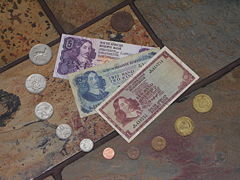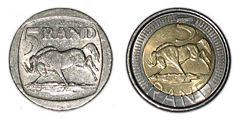South African rand
| South African rand Suid-Afrikaanse rand (Afrikaans) |
|||||
|
|||||
| ISO 4217 Code | ZAR | ||||
|---|---|---|---|---|---|
| User(s) | and Common Monetary Area: |
||||
| Inflation | 13.60% (South Africa only) | ||||
| Source | South African Reserve Bank, August 2008 | ||||
| Method | CPI | ||||
| Pegged with | Lesotho loti, Swazi lilangeni and Namibian dollar at par | ||||
| Subunit | |||||
| 1/100 | cent | ||||
| Symbol | R | ||||
| cent | c | ||||
| Plural | Rand | ||||
| Coins | 5c, 10c, 20c, 50c, R1, R2, R5 | ||||
| Banknotes | R10, R20, R50, R100, R200 | ||||
| Central bank | South African Reserve Bank | ||||
| Website | www.reservebank.co.za | ||||


The rand (sign: R; code: ZAR) is the currency of South Africa. It takes its name from the Witwatersrand (White-waters-ridge in English), the ridge upon which Johannesburg is built and where most of South Africa's gold deposits were found. The rand has the symbol "R" and is subdivided into 100 cents, symbol "c". The ISO 4217 code is ZAR, from Dutch Zuid-Afrikaanse rand.[1]
The rand is the currency of the Common Monetary Area between South Africa, Namibia, Swaziland and Lesotho.
Contents |
History
The rand was introduced in 1961, coinciding with the establishment of the Republic of South Africa. It replaced the South African pound as legal tender, at the rate of 2 rand = 1 pound or 10 shillings to the rand.
Coins
Coins were introduced in 1961 in denominations of ½, 1, 2½, 5, 10, 20, 50 cents. In 1965, 2-cent coins replaced the 2½-cent coins. The ½-cent coin was last struck for circulation in 1973. The 2-rand was introduced in 1989, followed by 5-rand coins in 1994. The 1- and 2-cent coins were discontinued in April 2002, primarily due to inflation having devalued them. All prices are now rounded to the nearest 5 cents.
In an effort to curb counterfeiting, a new R 5 coin was released in August 2004, as well as new banknotes in February 2005. Security features introduced on the coin include a bi-metal design (similar to the €1 and €2 coins, the Thai 10 Baht coin, the British £2 coin and the Canadian $2 coin), a specially-serrated security groove along the rim and micro-lettering. The new notes also feature a number of new security features.
Banknotes
The first series of rand banknotes was introduced in 1961 in denominations of 1, 2, 10 and 20 rand, with similar designs and colours to the preceding pound notes to ease the transition. They bore the image of Jan van Riebeeck, the first V.O.C. administrator of Cape Town. Like the last pound notes, they came in two variants, one with English written first and the other with Afrikaans written first. This practice was continued in the 1966 series which included the first 5 rand notes but did not include the 20 rand denomination.
The 1978 series began with denominations of 2, 5 and 10 rand, with 20 and 50 rand introduced in 1984. This series saw a major design change. In addition, the series has only one variant for each denomination of note. Afrikaans was the first language on the 2, 10 and 50 rand, while English was the first language on 5 and 20 rand. The notes still bore the image of Jan van Riebeeck.
In the 1990s, the notes were redesigned with images of the Big Five wildlife species. With the 2 and 5 rand coins replacing notes, notes were introduced in 1994 for 100 and 200 rand.
The 2005 series has the same principal design, but with additional security features such as colour shifting ink on the 50 rand and higher and the EURion constellation. The obverses of all denominations are printed in English, while two other languages are printed on the reverses, making all eleven official languages of South Africa available.
Brief exchange rate history
A rand was worth more than a U.S. dollar from the time of its inception in 1961 until 1982, when mounting political pressure combined with sanctions placed against the country because of apartheid started to erode its value. The currency broke above parity with the dollar for the first time in March 1982, and continued to trade between R 1–R 1.30 to the dollar until June 1984, when depreciation of the currency gained momentum. By February 1985, it was trading at over R 2 per dollar, and in July that year all foreign exchange trading was suspended for 3 days to try and stop the devaluation.
By the time that State President PW Botha made his infamous Rubicon speech on 15 August 1985, it had weakened to R 2.40 per dollar. The currency recovered somewhat between 1986–88, trading near the R 2 level most of the time and even breaking beneath it sporadically. The recovery was short-lived however, and by the end of 1989 the rand was trading at levels of more than R 2.50 per dollar.
As it became clear in the early 1990s that the country was destined for black majority rule and one reform after the other was announced, uncertainty about the future of the country hastened the depreciation until the level of R 3 to the dollar was breached in November 1992. A host of local and international events influenced the currency after that, most notably the 1994 democratic election which saw it weaken to over R 3.60 to the dollar, the election of Tito Mboweni as the new governor of the South African Reserve Bank, and the inauguration of President Thabo Mbeki in 1999 which saw it quickly slide to over R 6 to the dollar. The controversial land reform program that was kicked off in Zimbabwe, followed by the September 11, 2001 attacks, propelled it to its weakest historical level of R 13.84 to the dollar in December 2001.
This sudden depreciation in 2001 led to a formal investigation, which in turn led to a dramatic recovery. By the end of 2002, the currency was trading at under R 9 to the dollar again, and by the end of 2004 was trading at under R 5.70 to the dollar. The currency softened somewhat in 2005, and was trading at around R 6.35 to the dollar at the end of the year. At the start of 2006 however, the currency resumed its rally, and, as of 19 January 2006, was trading at under R 6 to the dollar again. However, during the second and third quarters of 2006 (ie April through September), the Rand weakened significantly. In Sterling terms, it fell from around 9.5p to just over 7p, losing some 25% of its international trade-weighted value in just six months. Late in 2007, the Rand rallied modestly to just over 8p, only to experience a precipitous slide during the first quarter of 2008. As at the time of writing (Friday, October 24) the Rand stands at 10.9 to the dollar.
This downward slide could be attributed to a range of factors: South Africa's worsening current account deficit, which widened to a 36-year high of 7.3% of Gross Domestic Product (GDP) in 2007; inflation at a five-year high of just under 9%; escalating global risk aversion as investors' concerns over the spreading impact of the sub-prime crisis grew; and a general flight to "safe havens", away from the perceived risks of emerging markets. The Rand depreciation was exacerbated by the Eskom electricity crisis, which resulted in the utility being unable to meet the country's rapidly growing energy demands. In particular, major mines were shut down, with Eskom warning that major new industrial projects could not be powered until additional power generation capacity could be brought on stream - something unlikely to be achieved for at least another 5 years. This would have a significant impact on production and exports by South Africa's mining industry, and would thus worsen an already worrisome current account deficit. It is particularly unfortunate that this should have happened at a time of record high prices for hard and soft commodities.
| From Yahoo! Finance: | AUD CAD CHF EUR GBP HKD JPY USD |
| From XE.com: | AUD CAD CHF EUR GBP HKD JPY USD |
| From OANDA.com: | AUD CAD CHF EUR GBP HKD JPY USD |
See also
- Witwatersrand
- Krugerrand
- Economy of South Africa
References
- Krause, Chester L. and Clifford Mishler (1991). Standard Catalog of World Coins: 1801-1991 (18th ed. ed.). Krause Publications. ISBN 0873411501.
- Pick, Albert (1994). Standard Catalog of World Paper Money: General Issues. Colin R. Bruce II and Neil Shafer (editors) (7th ed. ed.). Krause Publications. ISBN 0-87341-207-9.
External links
- US Federal Reserve Bank historical exchange rate data
- South African Currency Page, with a short description of each note.
- South African Currency Page (old rand), a short description of pre-1994 (apartheid-era) notes.
| Preceded by: South African pound Reason: decimalization Ratio: 2 rand = 1 South African pound = 1 British pound |
Currency of South Africa 1961 – |
Succeeded by: Current |
||
| Currency of South West Africa 1961 – 1990 Note: administered by/occupied by South Africa since 1915 |
Currency of Namibia 1990 – 1993 |
Legal tender in Namibia 1993 – |
Succeeded by: Namibian dollar Reason: withdrawal from Common Monetary Area Ratio: at par Note: dollar introduced in 1993, with South African rand remaining legal tender |
|
| Currency of Basutoland 1961 – 1966 |
Currency of Lesotho 1966 – 1980 |
Legal tender in Lesotho 1980 – |
Succeeded by: Lesotho loti Note: loti introuced in 1980, with South African rand remaining legal tender |
|
| Currency of Swaziland 1961 – 1974 |
Legal tender in Swaziland 1974 – 1986 |
Circulates in Swaziland 1986 – |
Succeeded by: Swazi lilangeni Note: lilangeni introduced in 1974. South African rand continues to circulate unofficially |
|
| Currency of Bechuanaland Protectorate 1961 – 1966 |
Currency of Botswana 1966 – 1976 |
Succeeded by: Botswana pula Reason: creation of independent currency Ratio: at par |
||
|
|||||||||||||||||
|
||||||||||
